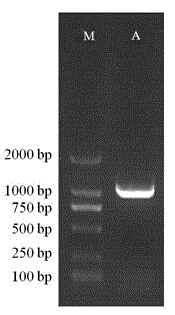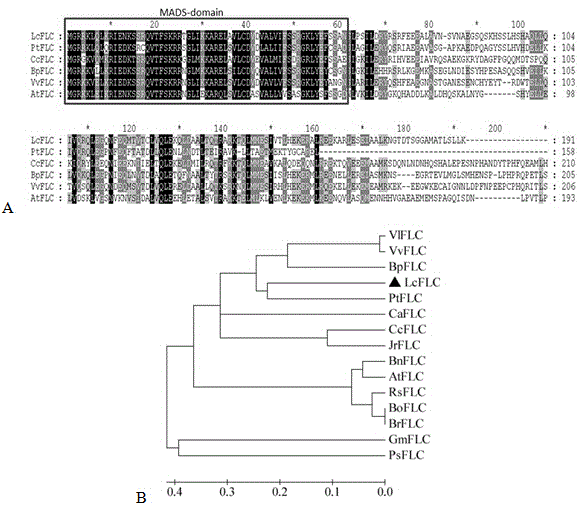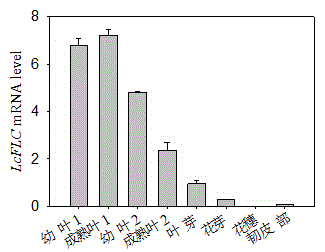Gene LcFLC for retarding flowering time of plants and application thereof
A gene and regulation gene technology, applied in the field of vector construction, delayed flowering gene, and cloning of plant flowering time gene LcFLC, can solve the problems of low temperature-induced lychee flowering regulation mechanism and molecular mechanism are unclear, delayed flowering time and other problems
- Summary
- Abstract
- Description
- Claims
- Application Information
AI Technical Summary
Problems solved by technology
Method used
Image
Examples
Embodiment 1
[0026] Cloning method and sequence analysis of embodiment 1 LcFLC gene
[0027] The cloning method and sequence analysis of the above-mentioned LcFLC gene include the following steps.
[0028] 1. Extraction and detection of lychee RNA The leaves of the 'feizixiao' lychee variety were used as materials. The RNA was extracted using the RNAOUT kit of Beijing Huayueyang Biological Co., Ltd. (refer to the instruction manual for the specific method), and then digested and removed with DNaseI (TaKaRa) DNA in total RNA (refer to the instructions for specific methods).
[0029] Litchi total RNA quality and integrity detection: Take 1 μL RNA solution and dilute it to 100 μL, measure the light absorption values at 260, 280 and 320 nm with an ultraviolet nucleic acid protein detector and calculate A 260nm / A 280nm Ratio; at the same time, take 2 μL RNA samples and use 1.2% agarose gel electrophoresis to detect the integrity of the total RNA. When A 260 / A 280 When the ratio is betw...
Embodiment 2
[0037] Example 2 Expression Analysis of LcFLC Gene in 'Concubine Smile' Litchi The expression analysis of LcFLC gene in 'Concubine Smile' litchi was carried out by Real-Time PCR reaction, and the specific embodiment is as follows.
[0038] 1. Experimental materials In order to analyze the expression of LcFLC gene in the process of litchi flower bud differentiation, RNA samples from 8 different parts of litchi and different growth stages were selected for analysis. The samples of different parts are as follows: mature leaf 1 (October), Mature leaf 2 (February), young leaf 1 (October), young leaf 2 (February), leaf buds, flower buds, flower spikes and phloem. The samples of different growth stages are the mature leaves and terminal buds of the last branch shoot of litchi 'Feizixiao' taken every 3 weeks since 2012.10.22 during the flowering process.
[0039] 2. Quantitative primer design According to the cloned gene sequence, refer to the general principles of Real-timePCR primer...
Embodiment 3
[0042] Example 3 A plant expression vector containing the LcFLC gene was constructed and transformed into Nicotiana benthamiana by Agrobacterium injection, and the subcellular localization of the LcFLC gene was further analyzed.
[0043] 1. Vector construction This experiment uses the pBI121 vector that has been partially modified (replacing the GUS gene in pBI121 with GFP), referred to as the pBI121-GFP vector (such as Figure 5 A). Select XbaI and SmaI restriction sites for enzyme digestion, then electrophoresis detection and gel cutting to recover fragments of corresponding size. Then use In-fusion? HDCloningKit ligase (Clontech) to connect the obtained target gene into the pBI121-GFP linear vector. The primers for amplifying the target gene with the recombination adapter are LcFLC-GFP-F: GGACTCTAGAGGATCCATGGGCCGGAGGAAGTTGCAG, and LcFLC-GFP-R: GATCGGGGAAATTCGAGCTCCTATTTTAGCAAGGAAAGGG. The connection system is: 1 μL of In-Fusion modified target gene, 1 μL of digested vecto...
PUM
| Property | Measurement | Unit |
|---|---|---|
| molecular weight | aaaaa | aaaaa |
Abstract
Description
Claims
Application Information
 Login to View More
Login to View More - R&D
- Intellectual Property
- Life Sciences
- Materials
- Tech Scout
- Unparalleled Data Quality
- Higher Quality Content
- 60% Fewer Hallucinations
Browse by: Latest US Patents, China's latest patents, Technical Efficacy Thesaurus, Application Domain, Technology Topic, Popular Technical Reports.
© 2025 PatSnap. All rights reserved.Legal|Privacy policy|Modern Slavery Act Transparency Statement|Sitemap|About US| Contact US: help@patsnap.com



